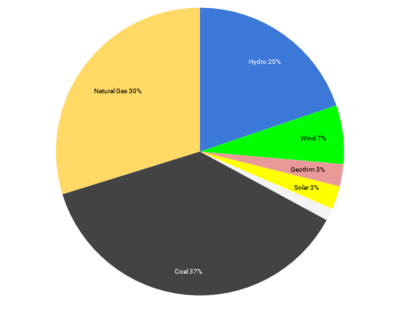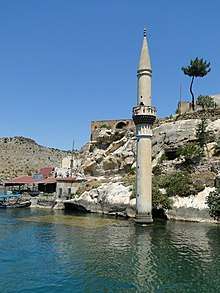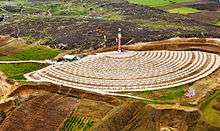Electricity sector in Turkey
Each year about 300 TWh of electricity is used in Turkey, which is almost a fifth of the amount of primary energy in Turkey. As the electricity sector in Turkey burns much local and imported coal the largest source of greenhouse gas emissions by Turkey is the country's coal-fired power stations, many of which are subsidized. Imports of gas, mostly for power stations in Turkey, is the main import cost for the economy of Turkey. However solar power in Turkey and wind power in Turkey are being increased and balanced by the country's existing hydropower.
| Data | |
|---|---|
| Installed capacity (2019) | 90 GW [1] |
| Production (2019) | 308.5 terawatt-hours [2] |
| Share of fossil energy | 56% [2] |
| Share of renewable energy | 44% [2] |
| Average electricity use (2019) | 2855 kWh per capita [3] |
| Distribution losses (2019) | 11,8%[4] |
| Residential consumption | % |
| Services | |
| Sector unbundling | No |
| Competitive supply to large users | No |
| Competitive supply to residential users | No |

History
Late Ottoman and early Republican Eras

Generating from 1914 Silahtarağa Power Station in Istanbul was the first in the Ottoman Empire, apart from a small hydroelectric power station built in 1902 outside Tarsus in Anatolia.[5] By 1923, the start of the Turkish Republic, one in twenty of the population was supplied with electricity.[5]
State ownership 1930s to late 20th century
The electricity sector was nationalized in the late 1930s and early 1940s, and by the end of nationalization almost a quarter of the population was supplied with electricity.[6] By the end of the 20th century almost all the population was supplied with electricity.
Late 20th and early 21st century
Privatization of the electricity sector started in 1984[6] and began "in earnest" in 2004[7] after the Electricity Market Law was passed in 2001.[8] There was a one-day national blackout in 2015 and an independent energy exchange was created.[8] In the 2010s the Turkish Electricity Transmission Corporation (TEİAŞ) joined the European Network of Transmission System Operators as an observer.[9]
Consumption
Just over 300 TWh was used in 2019,[9] with demand peaking at 52 GWe in August.[10] Total demand in 2020 is forecast to be similar.[11]
Efficient use
In the five years from 2019 Turkey plans to invest US$11 billion in energy efficiency.[12] Also a target of 80% smart meters by 2035 has been set.[13]
Demand Forecasts
Electricity's share of final energy demand was about a fifth in 2018 but is expected to increase.[14] In October 2018 the government forecast electricity demand of 317 TWh for 2019.[15] However 2018 demand turned out to be 303 TWh, (from an installed capacity of 89GW)[16] an increase of less than 1% on 2017.[17] So that 2019 forecast would be a 5% increase with the economy predicted for recession, and in the past several demand forecasts have been overestimates,[18] sometimes due to overestimates of economic growth.[19]
One 2018 academic forecast was that by 2021 demand will be between 322 and 345 TWh.[20]
As of April 2019 the Energy Ministry was predicting demand of 357 TWh by 2023.[9]
As of 2019 the ministry forecast for 2030 demand was 500 TWh[21] and another forecast predicts between 440 and 550 TWh.[22]
However as of 2019, there is about one third[23] surplus generating capacity.[24]
Electrification
At least one charger per 50 parking spaces in public areas and shopping malls is required.[25] Production by electric vehicle companies, such as TOGG, may not be enough to avoid the risk to the economy of Turkey of high oil import bills in the mid-2020s.[26]
Generation
Of the total 308.5 terawatt-hours of electricity generated in 2019 coal's share was 114.6 terawatt-hours(37%), hydropower 89.2(29%), natural gas 58.1(19%), wind, solar, and geothermal 45.3(15%).[27] Installed capacity was 90GW in 2019.[28] As well as the state owned Electricity Generation Company (EUAŞ) there are many private companies.
Trade
In 2019 about 150TWh was traded on the day ahead spot market, about half of the 300 TWh generated, at an average rate of 260 lira for each megawatt hour.[29]
Transmission
TEİAŞ is the transmission system operator.[30] According to a 2018 study by Sabancı University 20% of Turkey's electricity could be generated from wind and solar by 2026 with no extra transmission costs, and 30% with a minor increase in grid investment.[31] Mobile 10MW batteries may be useful in future for reducing temporary transmission congestion between regions, or larger ones for frequency regulation.[32]
Distribution
Electric power distribution is done by the Turkish Electricity Transmission Corporation and regional monopolies.[33][34] According to academics at the Shura Energy Center Increasing Turkey's proportion of electric cars in use to 10% by 2030 would smooth distribution, amongst many other benefits.[35]
Standards
Schuko plugs and sockets are the standard, at 220 V and 50 Hz.[36] For public charging of electric vehicles the European standard Combined Charging System is used but there are also some CHAdeMO chargers.[37] As of 2020 there are no Tesla superchargers.
Resilience
Although the nationwide blackout in 2015 was not caused by a natural disaster, the installation of more local solar power with batteries and microgrids in vulnerable places might help vital buildings such as hospitals retain power after the next earthquake in Turkey. Academics suggest that cost–benefit analysis of such systems should take into account any benefits of resilience and also the cost of installing an islandable system.[38][39]
Policy and regulation
Governments is aiming for half of electricity to be from renewable energy in Turkey by 2023,[40] with capacity targets of 34 GW for hydropower, 20 GW for wind, 5 GW for solar PV, 1 GW for biomass, and 1 GW for geothermal. The authors of a report from Shura Energy Transition Center at Sabancı University have suggested that longer-term plans and targets would also be useful, together with a higher target for solar, policy on distributed generation, and market design to incentivize grid flexibility.[41] The objectives are developing local manufacturing capacity, technology transfer, and creating a competitive domestic market for low-cost renewable energy.[42] For wind and solar tenders there is a high domestic content requirement, and imported solar modules are taxed. As of 2019 the costs and benefits of attempting to enhance local manufacturing capacity are still uncertain, especially for solar.[40] Developing regulation to specify the role of aggregators in providing flexibility and including energy storage systems and demand side management within ancillary services has been suggested.[43]
Subsidies
Coal in Turkey is heavily subsidized. The current feed-in tariff system for renewables expires in 2020.[41]
Environmental impact

The largest source of greenhouse gas emissions by Turkey is the country's coal-fired power stations, many of which are subsidized. The older coal-fired power stations also cause local air pollution in Turkey.[44]
Economics and finance
As elsewhere new renewables are auctioned.[45] As of 2018 if all currently economic renewable projects were developed, the added electricity generation would be sufficient to reduce Turkey's natural gas imports by 20%.[46][47]
The wholesale market is operated by Energy Exchange Istanbul (EXIST)[48] and wholesale prices are controlled by EUAŞ, the state electricity generation company.[49] In January 2019 EDPK published estimates of power plant financing.[50]
Prices to end consumers are regulated by the government.[51] A green tariff is planned for 2020.[52]
Ownership of generators
As of 2019 about 15% of power was generated by the public sector.[23] During the 2010s power companies borrowed heavily in dollars, but economic growth was overestimated and they overbuilt generating capacity:[23] by September 2019 they had bank debts of $34 billion but revenues had declined in dollar terms due to the fall in the lira and 7% of debts were nonperforming.[40][53][23] There is uncertainty over what will happen when the renewable energy support scheme (YEKDEM) finishes at the end of 2020.[54] In 2020 Turkish companies in general still owe much foreign currency[55] and debt may be restructured and plants may change ownership.[56]
International Trade
About half the electricity used in 2019 was generated from local resources.[57] Although the grid is synchronised with the European Network of Transmission System Operators for Electricity (ENTSO-E) and linked across most land borders, only about 1% of electricity is imported or exported.[58]
Future
In April 2019 Shanghai Electric Power, a subsidiary of China's State Power Investment Corporation, signed a Belt and Road Initiative deal to build the 1320 MW Hunutlu power station,[59] which would burn coal imported to Adana Province through Iskenderun Bay.[60] The project finance includes a 15-year $1.381 billion loan from China Development Bank, Industrial and Commercial Bank of China, Bank of China and Industrial and Commercial Bank of China.[59] However the project is being opposed by several environmental organisations.[61] As of 2020 there is an oversupply of generating capacity and the drop in demand may create financial problems for power plant operators.[62]
References
- Godron, Philipp and Mahmut Erkut Cebeci and Osman Bülent Tör and Değer Saygın (2018). Increasing the Share of Renewables in Turkey's Power System:Options for Transmission Expansion and Flexibility (PDF). SHURA Energy Transition Center. ISBN 978-605-2095-22-5.
- Godron, Philipp and Değer Saygın (2018). Lessons from global experiences for accelerating energy transition in Turkey through solar and wind power (PDF). SHURA Energy Transition Center. ISBN 978-605-2095-40-9.
- Sarı, Ayşe Ceren and Değer Saygın (2018). On the way to efficiently supplying more than half of Turkey's electricity from renewables: Opportunities to strengthen the YEKA auction model for enhancing the regulatory framework of Turkey´s power system transformation (PDF). SHURA Energy Transition Center. ISBN 978-605-2095-44-7.
- "Electricity".
- AA, DAILY SABAH WITH (2020-06-21). "Natural gas share of Turkey's electricity output down over 37% in 2019". Daily Sabah. Retrieved 2020-07-16.
- https://www.iha.com.tr/haber-turkiyede-kisi-basina-dusen-elektrik-tuketimi-2855-kwh-oldu-784151/
- https://www.aa.com.tr/tr/ekonomi/epdknin-tesvigi-elektrikte-kayip-kacagi-azaltti/1463916
- "Ownership of the electricity market in Finland and Turkey (1900-2000)". Retrieved 2020-07-06.
- WorldBank (2020), p. 58.
- "Power in Turkey" (PDF).
- "Turkish Energy Market Outlook" (PDF).
- "Electricity". Ministry of Energy and Natural Resources (Turkey).
- Direskeneli, Haluk (2019-12-02). "Turkey: Energy And Infrastructure Forecast 2020 – OpEd". Eurasia Review. Retrieved 2019-12-04.
- "Turkey's power demand grows as normalization begins". Hürriyet Daily News. Retrieved 2020-07-06.
- "Turkey set to invest $11 billion in energy efficiency". Anadolu. 10 April 2019.
- "Turkey sets its roadmap for smart grids". Anadolu. 26 April 2018.
- "Energy pricing and non-market flows in Turkey's energy sector" (PDF). SHURA Energy Transition Center.
- "Afşin-Elbistan Termik Santral yatırımı, Cumhurbaşkanlığı 2019 Yılı Programı'nda Yer Aldı". Elbistan Kaynarca. 30 October 2018.
- "Turkey's electricity consumption falls 0.9 pct in February". Hürriyet Daily News. 1 March 2019.
- "Turkey likely to see new big energy investments by 2020: Bank executive". Hürriyet Daily News. 23 February 2019.
- Dincer, Ibrahim; Midilli, Adnan; Kucuk, Haydar (2014-06-17). Progress in Exergy, Energy, and the Environment. Springer. ISBN 978-3-319-04681-5.
- Sonmez, Mustafa (2019-12-19). "Turkey's energy miscalculations have hefty cost". Al-Monitor. Retrieved 2020-07-06.
- Şahin, Utkucan (2019). "Forecasting of Turkey's electricity generation and CO2 emissions in estimating capacity factor". Environmental Progress & Sustainable Energy. 38: 56–65. doi:10.1002/ep.13076.
- "Turkey may benefit from nuclear power in its bid for clean energy". DailySabah. Retrieved 2019-07-14.
- "Turkey invested $650M in wind power plants last year". Daily Sabah. 13 February 2019.
- Sonmez, Mustafa (2019-12-19). "Turkey's energy miscalculations have hefty cost". Al-Monitor. Retrieved 2019-12-21.
- "$7.5B of $10B energy finance for 2019 restructured". DailySabah. Retrieved 2019-11-01.
- Saygın et al (2019), p. 20.
- "Europe could face oil shortage in a decade, study warns". The Guardian. 2020-06-22. Retrieved 2020-06-23.
- "Natural gas share of Turkey's electricity output down over 37% in 2019". Daily Sabah. 2020-06-21.
- "Turkey's daily wind power generation sets record". DailySabah. Retrieved 2019-09-27.
- "Spot electricity market trade volume up 17 pct in 2019 - Latest News". Hürriyet Daily News. Retrieved 2020-02-13.
- "ABOUT US". TEİAŞ. Retrieved 18 April 2019.
- Godron (2018), p6
- Kocer, Mustafa Cagatay; Cengiz, Ceyhun; Gezer, Mehmet; Gunes, Doruk; Cinar, Mehmet Aytac; Alboyaci, Bora; Onen, Ahmet (January 2019). "Assessment of Battery Storage Technologies for a Turkish Power Network". Sustainability. 11 (13): 3669. doi:10.3390/su11133669.
- "Dağıtım Şirketleri". Türkiye Elektrik Dağıtım A.Ş. Retrieved 18 April 2019.
- "Electricity Regulation in Turkey". Lexology. Retrieved 18 April 2019.
- Transport sector transformation: Integrating electric vehicles into Turkey’s distribution grids (PDF) (Report).
- "Electricity, Electric Plugs & Sockets/Points in Turkey". Turkey Travel Planner. Retrieved 2020-06-20.
- "Enerji Sektörünün Vicdan Muhasebesi Volume I: Enerji Bürokrasisinde Karar Trajedileri". Enerji Portalı (in Turkish). 2020-01-22. Retrieved 2020-06-20.
- Bajwa, Abdullah Akram; Mokhlis, Hazlie; Mekhilef, Saad; Mubin, Marizan (2019-05-01). "Enhancing power system resilience leveraging microgrids: A review". Journal of Renewable and Sustainable Energy. 11 (3): 035503. doi:10.1063/1.5066264.
- "Valuing the Resilience Provided by Solar and Battery Energy Storage Systems" (PDF).
- "RENEWABLE ENERGY INVESTMENT IN TURKEY: BETWEEN ASPIRATION AND ENDURANCE". Turkish Policy Quarterly. Retrieved 27 November 2018.
- Godron&Saygın (2018), p108
- Sarı&Saygın (2018), p7
- Transition towards a decarbonised electricity sector –A framework of analysis for power system transformation (PDF) (Report). p. 49.
- "Six coal-fired plants continue to emit thick smoke after end of suspension". bianet. 2 July 2020.
- "Turkish PV defies political ghosts in year of the rooftop". PV Tech. Retrieved 2020-07-06.
- "Turkey's Energy Sector Dynamics". Atlantic Council. 6 December 2019.
- Ozcan, Mustafa (2018). "The role of renewables in increasing Turkey's self-sufficiency in electrical energy". Renewable and Sustainable Energy Reviews. 82: 2629–2639. doi:10.1016/j.rser.2017.09.111.
- "About Us". Energy Exchange Istanbul (EXIST). Retrieved 18 April 2019.
- "Turkish lira tumble triggers electricity curtailment fears". ICIS. 13 August 2018.
- "TÜRKİYE ELEKTRİK PİYASASININ ARZ TARAFI" (PDF). Retrieved 1 April 2019.
- "Turkey presses banks to agree high-stakes bailout of bad energy loans". Reuters. 13 May 2019.
- DHA, Daily Sabah with (2020-07-03). "Turkey to offer 'green only' power tariff as of August". Daily Sabah. Retrieved 2020-07-06.
- Direskeneli, Haluk (10 January 2019). "Turkey: Energy And Infrastructure Forecast, Risks And Opportunities 2019 – OpEd". Eurasia Review.
- Energy Deals 2019 (Report). PricewaterhouseCoopers. February 2020.
- "Emerging-market lockdowns match rich-world ones. The handouts do not". The Economist. ISSN 0013-0613. Retrieved 2020-04-29.
- DİRESKENELİ, Haluk (2020-01-03). "Enerji piyasalarında 2020 yılı öngörüleri - Haluk DİRESKENELİ". Enerji Günlüğü (in Turkish). Retrieved 2020-01-04.
- "Hydroelectric best energy choice for Turkey, research shows". www.electricityturkey.com (in Turkish). Retrieved 2020-06-20.
- "Turkish energy sector hit by lira depreciation: MUFG research". S & P Global. 17 August 2018.
- "SEP Completes Facility Agreement Signing for Turkey Hunutlu Thermal Power Plant Project under Belt and Road Initiative". Shanghai Electric Power. Retrieved 6 May 2019.
- "EMBA Hunutlu power station". Global Energy Monitor. Retrieved 6 May 2019.
- "Chinese private company wants to build a coal power plant on protected beach in Iskenderun Bay, Turkey". Health and Environment Alliance. Retrieved 6 May 2019.
- "Turkey's electricity demand falls as coronavirus constricts economic activity". Daily Sabah. 2020-03-31.
Sources
- 2019-2023 Strateji̇k Plani [2019-2023 Strategic Plan] (PDF) (Report) (in Turkish). Ministry of Energy and Natural Resources (Turkey). May 2020.
- EÜAŞ - A briefing for investors, insurers and banks (PDF) (Report). Europe Beyond Coal. January 2020.
- Saygın, Değer; Tör, Osman Bülent; Teimourzadeh, Saeed; Koç, Mehmet; Hildermeier, Julia; Kolokathis, Christos (December 2019). Transport sector transformation: Integrating electric vehicles into Turkey’s distribution grids (PDF). SHURA Energy Transition Center (Report).
- Türki̇ye’ni̇n Enerji̇ Görünümü 2020 [Turkey's energy view 2020] (Report) (in Turkish). TMMOB Maki̇na Mühendi̇sleri̇ Odasi. May 2020.
- Turkey’s Energy Transition: Milestones and Challenges (Report). World Bank. 2015.
